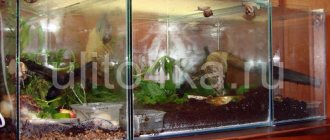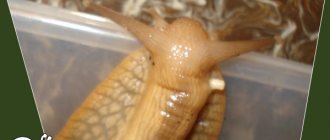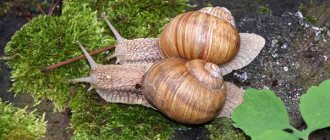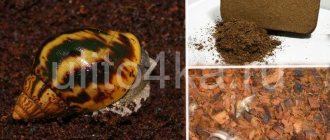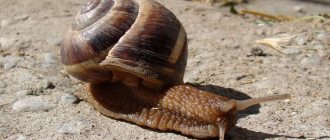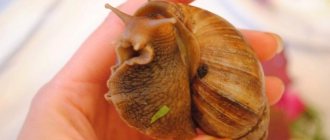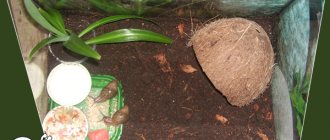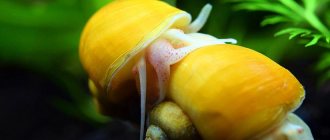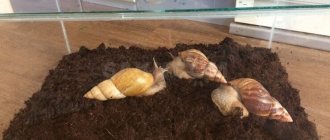Reproduction of Achatina mollusks at home requires care and attention on the part of the owner. These land animals are hermaphrodites (they have both male and female characteristics); Achatina reproduces well even in captivity. Before you start breeding, it is important to understand that Achatina snail eggs are laid in large quantities. It is necessary to create a favorable atmosphere that will be beneficial for future Achatina snails.
Preparation for reproduction
In the Achatina snail, reproduction occurs only if the aquarium or terrarium meets certain requirements. Despite the fact that Achatina are hermaphrodites, they need a partner in order to mate. To reproduce, a pair of Achatina must be moved to a separate container.
In order to breed healthy and full-fledged offspring, you need to create the following living conditions for mollusks:
- the size of the aquarium must be at least 15 liters;
- no temperature changes, it should stay around 27–28 degrees;
- It is recommended to cover the bottom of the aquarium with 100 mm thick damp coconut soil;
- for pregnant Achatina, as well as after laying eggs, add calcium to food;
- The terrarium must be kept clean.
The following is used as a supplement containing calcium:
- chalk stone;
- mineral stone;
- sepia;
- small shell rock.
Gender of the snail
The question of determining the sex of an individual is of interest to every breeder; as stated earlier, they have no sexual differences; it is impossible to determine the sex and divide snails into male and female. Achatina cannot reproduce alone, without a partner; a companion is needed for mating. The eldest large individual becomes the female. This is due to the fact that pregnancy requires a lot of physical strength, therefore, the strongest representatives are selected in order to ensure healthy offspring.
Pair of Achatina snails
Stimulation of reproduction
Stimulating a mollusk to reproduce consists primarily of organizing all the necessary conditions related to preparation for mating. The terrarium should be thoroughly washed and cleaned; if the soil is dry and its thickness does not reach 10 cm, then it should be replaced. The soil must be clean. Artificial ponds should be temporarily removed from the terrarium. It is also important to make sure that only healthy Achatina mates.
Time of maturation of egg laying
You will need preparation to create a good environment for the newborn snails. Therefore, you need to know how long it takes for Achatina snails to hatch from eggs?
Under good conditions, after about 12-14 days, small Achatina snails will hatch from the eggs.
Newborn snails are tiny, delicate and almost transparent. Akhatina babies have such a fragile and thin shell that you can see their heart beating through it. If the snails hatch in their parents' terrarium, it is advisable to place them in a smaller container.
Attention! It is not recommended to handle small Achatina snails. This can cause irreparable harm to the crumbs and they will stop growing. It is advisable to use a plastic spoon to take the newborn snails along with the soil and move them to the nursery terrarium.
Reproduction of Achatina
Reproduction of Achatina snails is possible only with the onset of puberty. An individual is considered an adult from the moment it reaches the age of 6 months; Achatina is ready for mating after the appearance of a small tubercle on the neck, which is the reproductive organ of snails.
Immediately after the mating process, the time of pregnancy officially begins; during this period, the gastropod lays eggs. Pregnancy is different for every female. On average, Achatina snail eggs hatch in 1–2 months. It is possible to see the hatching eggs of Achatina if you look into the spiracle of Achatina.
There are recorded cases when a snail's pregnancy ends in childbirth, as a result of which Achatina gives birth to viable small mollusks.
The mollusk buries its future offspring in the ground; often for these purposes, Achatina prepares a hole in advance where they lay their eggs. Achatina snails are capable of breeding all year round, in separate places in small groups or together.
Pregnancy has a negative impact on the female; she should be fed well, adding various supplements.
Mr. Tail recommends: the most common aquarium snails
There are many varieties of aquarium snails, including omnivores and predators, which are bred separately. They come from Southeast Asia, Thailand, and Africa. In nature, they live in ponds, lakes, streams, and rivers.
| View | Description |
| Reels | Freshwater mollusks do not require special care and live even in dirty water. They reproduce very quickly, lifespan is 1 year. The shell looks like a narrow, twisted spiral with 4-5 turns. Color – bright red, brown. Reach 3.5 cm in nature, 1 cm in an aquarium. They crawl on surfaces and in water and live for one year. They eat dead algae and destroy bacterial film. |
| Physidae | Hermaphrodites, measuring 17 mm, in an aquarium 8-9 mm, often bring them in accidentally, along with plants. Ovoid shell up to 3-5 whorls, pink, brown, yellow-brown color. They eat leftover food and green deposits on glass. But they are useful only in small quantities. They live up to 2 years. |
| Ampoules | Peaceful snails, kept with fish, eat a lot, grow up to 15 cm. Yellow, also blue, white, black, blue are more common. They live for 2 years. |
| Melania | Viviparous, dioecious, gray mollusks live in the soil in the aquarium, loosen it and improve water circulation, appearing only at night. The carapace is in the form of a cone, 3 cm long, has 6-7 whorls. Lifespan – 2 years. |
| Helena | Predators love soft ground. Yellow with dark or black stripes. Diverse, reproduce slowly. They feed on snails. Dimensions 2 cm. Lives 2-4 years. |
| Tylomelania | Viviparous, beautiful, yellow, orange, olive, black, distinguished by an unusual structure. The mouth part is similar to the proboscis of a tapir. The body is bright yellow. Demanding on content. Lifespan – 2-3 years. |
| Neretina | They are heterosexual, similar to the Colorado potato beetle, small, clean the aquarium, but their eggs there are often not viable, they live for 2-3 years. Adapts poorly to new conditions. |
| Maryse | Up to 5 cm in size, beautiful, golden, twisted shell with dark stripes. They breathe atmospheric air, can leave the aquarium and walk around the house, are dioecious, males can be easily distinguished from females, and are omnivorous. They live from 2 to 4 years. |
| Pagodas (brothia) | A rare species, reaching 6 cm. Sensitive to the oxygen content in water. Viviparous, dioecious. They live no more than 6 months. |
Snails from natural bodies of water should not be kept at home (pond snails, meadows, pearl barley). They eat vegetation at the roots and carry diseases and pests.
Photo gallery of snails:
What do Achatina snail eggs look like?
After Achatina has laid eggs, aquarists can observe their appearance and further development. The clutch of Achatina is similar in appearance to fish eggs, which is why it received its second name, since the snail lays eggs in groups. Initially, caviar is a dense and elastic mucus, but soft to the touch. During the incubation process, snail eggs become harder and a shell appears at the time of hatching. The egg shell of the clutch has green and brown shades.
Achatina eggs
There are cases of false eggs being laid when they do not have a shell and are transparent in color. The shape of the caviar is always round. The size of Achatina eggs varies from 5 to 7 mm, sometimes smaller. Achatina hatch at home in a short period of time, from 17 to 24 hours, so all the offspring can hatch in one day. The number of eggs can reach 300 pieces, but, as a rule, no more than 100 snails hatch. The number of Achatina offspring laid differs from the cubs born. Newborn snails require high-quality care, just like a pregnant gastropod.
Self-fertilization
Snails are hermaphrodites, so there may be cases when a snail lays eggs while living alone. From such a clutch, offspring can hatch, since a double set of genes is present in all individuals.
Most often, self-fertilization occurs in Achatina immaculata. They don’t need a couple to prolong the race. Upon reaching five to six months, the snail can lay eggs. This happens less often in fulicas and reticulata; they prefer to reproduce in pairs.
How to care for Achatina eggs
Small Achatina require minimal care from the breeder. But it is necessary to regularly care for the egg laying and monitor environmental indicators.
If the snail laid eggs in a hole without covering it with soil, then you need to carefully sprinkle the eggs yourself.
It is important to ensure that the soil is moist; if necessary, add a small amount of water, but there should be no liquid under the masonry. The most favorable temperature for egg maturation will be 28 degrees, just as before, sudden changes should not be allowed.
Little Achatina
It is forbidden to touch the masonry with your hands. An exception may be a situation when a snail has deposited it in the territory of the terrarium, then it is necessary to carefully transfer the future offspring into one hole using some object. The temperature of a person's hands can cause harm.
A newborn mollusk grows very slowly and during this time the parents care for their offspring. The baby's shell is delicate and should be handled with care.
What to feed small Achatina snails
Immediately after birth, the mollusks stay inside the substrate for several days, only then they crawl out to the surface, doing this gradually. At first, babies eat eggshells from their own eggs, as well as false eggs. Further, it is recommended to feed small mollusks in the same way as an adult. Feeding should be frequent and regular, and access to food should be constant.
Calculation of costs and profitability
Costs and profitability are different for everyone who breeds snails.
It depends on some factors:
- Buying broodstock or raising it yourself.
- Forming pens with your own hands or buying ready-made ones.
- Use of special equipment (to maintain temperature, humidity and light).
You can raise the broodstock yourself (this applies to grape snails) depending on where you live. They can be found in Australia, Southern Russia and countries with temperate climates. You can buy a ready-made one, its price is about $200 for 50 pieces. To create a full-fledged snail farm, you will need 750 snails, the cost of which will be $3,000.
To maintain one snail you need about 2 rubles a month, that is, for 750 you need 1500 rubles. To purchase equipment (pens, ditches, boxes) you need about $500.
Hence the conclusion is drawn that to fully start a business you need to have $3,500 for snails and 1,500 rubles per month for their maintenance. Sales of one ton of snails will cost approximately $10,000. All costs will be recouped by 150% in eight months.
If the broodstock is formed independently, you can save about $3,000.
Assessing advantages and disadvantages
From all of the above, you can easily assess the advantages and disadvantages of this business.
Pros:
- You can start a business from scratch.
- Minimum monthly costs.
- Ease of breeding.
- No special nutrition required.
- You can breed it at your dacha.
- Benefits of snails.
- Possibility to combine business with main job.
Minuses:
- Difficulties associated with finding a sales market.
- 30% of snails die after laying eggs.
- Possible lack of breeding space.
- Slippery and nasty. You need to really love them or get used to them.
The snail business is not yet very widespread, so anyone who decides to do this can become successful and build a career with the help of snails. It is necessary to weigh the pros and cons so as not to regret it later, because this is a specific business.
